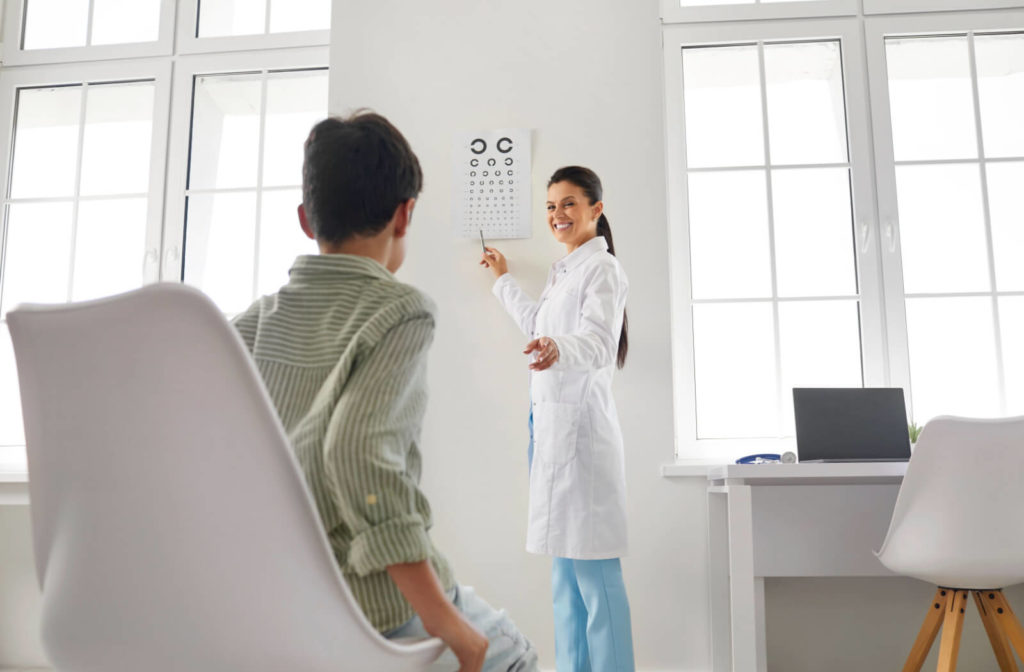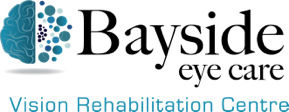Children’s eye exams serve a similar purpose as an adult’s eye exam at their root—to help maintain healthy eyes and clear vision. But the focus is typically on eye conditions or diseases common in children as opposed to age-related conditions more common in adults.
Astigmatism, nearsightedness (myopia), crossed eyes, and lazy eye are all common childhood conditions your child may be screened for in an eye exam. Your optometrist can also inform you about how these things could affect your child’s education and development and offer personalized treatment options or solutions.
Your child’s optometrist will typically give you recommendations on how often you should bring them back, along with things to be doing or watch out for in between exams.
What Is a Children’s Eye Exam?
A children’s comprehensive eye exam is similar to an adult’s. But 80% of a child’s learning is vision-based, so there is typically a heavier focus on maintaining adequate sight and the vision tools they need to succeed in school and in life.
Certain conditions like astigmatism, myopia, lazy eye, or crossed eyes are often common in children. These conditions can lead to learning trouble in school and other eye health complications in the future, like untreated high myopia.
Importance of Comprehensive Eye Exams
Treatment outcomes are often improved with the early diagnosis of eye disease or eye conditions. So, comprehensive eye exams are important regardless of one’s overall health or age.
An important discussion is vision screening vs. a comprehensive eye exam. A vision screening is often offered in a school setting or a doctor’s office. While a vision screening can complement a comprehensive exam, it shouldn’t replace one. Remember, 20/20 vision doesn’t always equal good overall eye health.
Frequency of Pediatric Eye Exam
There isn’t a hard answer as to how often a child should get a comprehensive eye exam because the frequency can be affected by their overall eye health and their medical history. The Canadian Association of Optometrists has some guidelines for exam frequency:
- One exam between 6 and 9 months old
- One exam between 2 and 5 years old
- Annual exams from 6 to 18 years old
It’s important to remember that these guidelines are recommendations. And your optometrist may recommend a different schedule based on their assessment of your child’s eyes.
What to Expect at Your Child’s Eye Exam
Every visit your child has to the eye doctor for a comprehensive examination may not always look the same. For example, there may be a lot of family history and medical questions from your child’s optometrist during an initial appointment, or you might have a period of time for questions afterward.
Common things you can expect during your child’s eye exam include:
- Questions on your child’s medical history and family history
- Visual acuity measurement
- Colour vision assessment
- Binocular vision assessment
- Overall eye health assessment
- Neurological assessment
- Refractive error correction
Common Eye Conditions in Children
A few common things your child’s eye doctor may be looking for during a comprehensive eye exam include the following.
Astigmatism
Astigmatism is a common refractive error caused by an abnormally shaped cornea or lens within the eye. This refractive error can develop at any time in a person’s life for various reasons but often occurs early in life, so your child’s eye doctor will typically check for it along with other refractive errors like myopia during a comprehensive exam.
Myopia
Myopia, also known as nearsightedness, is a common refractive error in children. It’s primarily characterized by the ability to see clearly up close but have blurry distance vision. Although it cannot be cured or reversed, there are various myopia controls that many optometrists offer to either slow or stop the condition’s progression.
Crossed Eyes
Crossed eyes, or strabismus, is a common childhood eye condition where the child’s eye muscles don’t work together to keep the eyes properly aligned. It typically develops in the first 6 to 8 years of a child’s life and may begin with very few signs. If left untreated, a child may develop double vision. Eventually, crossed eyes can lead to lazy eye if one eye begins to not function normally.
Lazy Eye
Although the name may sound offensive, lazy eye or amblyopia has nothing to do with “laziness.” The condition is essentially a breakdown in the connection between the brain and the affected eye, resulting in the eye wandering inward or outward. It’s commonly caused by untreated crossed eyes, but it can also be caused by an inaccurate prescription in the child’s eyeglasses lenses.
Book Your Pediatric Eye Exam Today
Your child’s optometrist plays an important part in their overall health and development, just like their pediatrician or family doctor. And the relationship your child builds with their optometrist can only benefit them later in life as their eye healthcare needs change or increase.Give us a call to schedule an exam at Bayside Eye Care if it’s time for your child to see the eye doctor. Our experienced staff can answer your questions and prepare you and your child for the exam.



